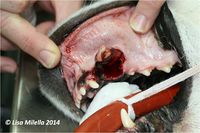Difference between revisions of "Luxated and Avulsed Teeth"
Jump to navigation
Jump to search
Michuang0720 (talk | contribs) |
|||
| Line 13: | Line 13: | ||
Injured teeth will require treatment - either [[Exodontics|extraction]] or replacement and stabilization, and once the tooth has re-attached, [[Endodontic Treatment|endodontic treatment]] will be required. | Injured teeth will require treatment - either [[Exodontics|extraction]] or replacement and stabilization, and once the tooth has re-attached, [[Endodontic Treatment|endodontic treatment]] will be required. | ||
| − | |||
| − | |||
| − | |||
{{Lisa Milella written | {{Lisa Milella written | ||
Revision as of 14:04, 2 November 2014
Introduction
Occasionally, veterinarians are presented with luxated or avulsed teeth.
Luxated = partly dislocated from the socket. The most common luxation is a lateral luxation together with fracture of the alveolar bone plate.
Avulsed = completely removed/pulled out of the socket
In these cases of trauma, the blood supply to the tooth is affected, resulting in pulp necrosis.
Injured teeth will require treatment - either extraction or replacement and stabilization, and once the tooth has re-attached, endodontic treatment will be required.
| This article was written by Lisa Milella BVSc DipEVDC MRCVS. Date reviewed: 13 August 2014 |
| Endorsed by WALTHAM®, a leading authority in companion animal nutrition and wellbeing for over 50 years and the science institute for Mars Petcare. |
Error in widget FBRecommend: unable to write file /var/www/wikivet.net/extensions/Widgets/compiled_templates/wrt6937bed0dc1e84_85939745 Error in widget google+: unable to write file /var/www/wikivet.net/extensions/Widgets/compiled_templates/wrt6937bed0e6bfc6_59433143 Error in widget TwitterTweet: unable to write file /var/www/wikivet.net/extensions/Widgets/compiled_templates/wrt6937bed0f1e1c4_21435817
|
| WikiVet® Introduction - Help WikiVet - Report a Problem |
